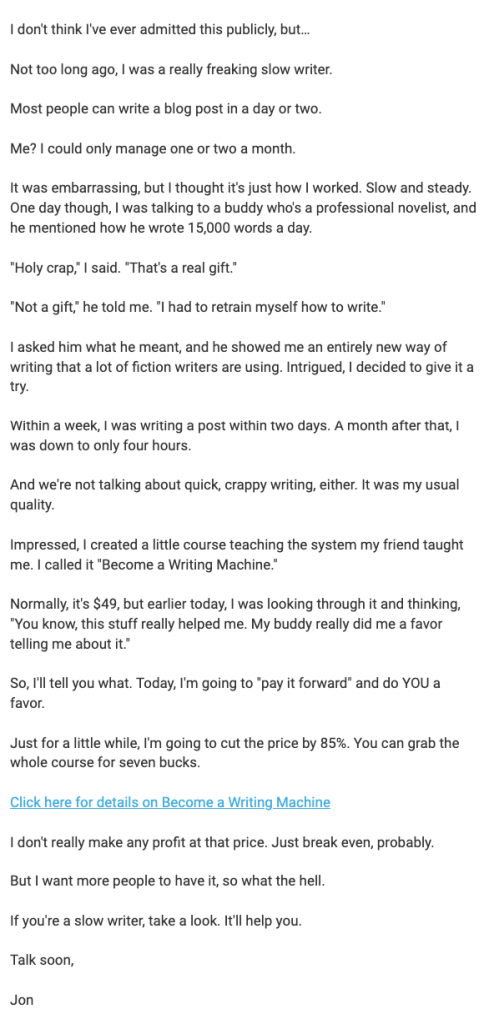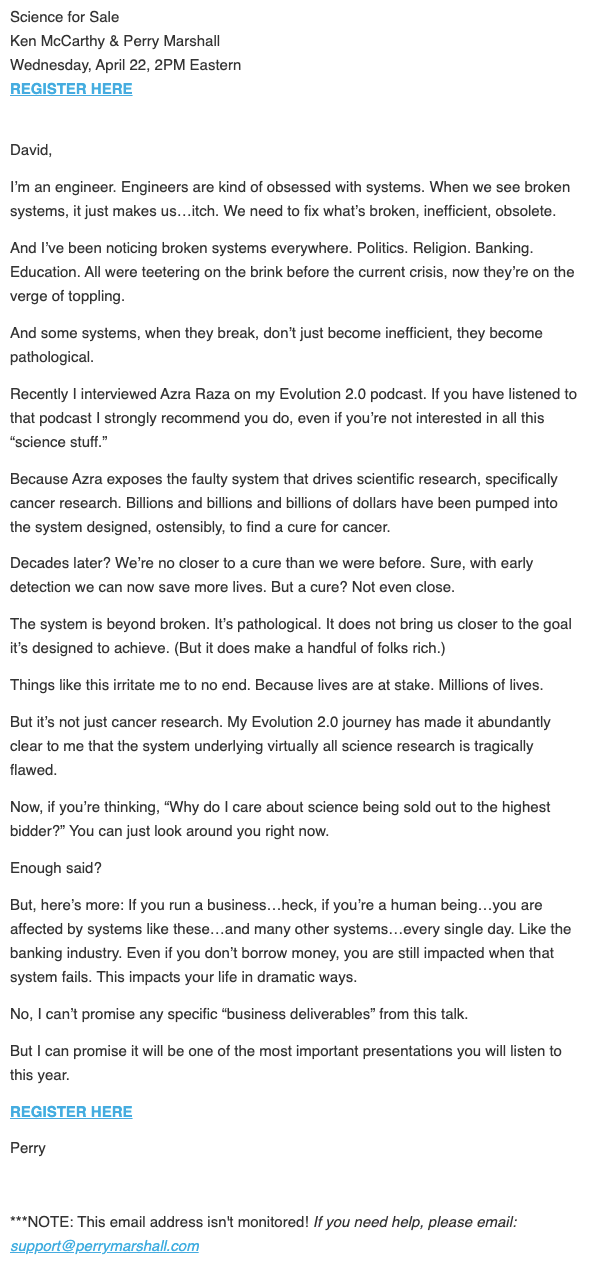
“All marketers are storytellers,” said Seth Godin in All Marketers are Liars.
He’s right.
Marketing is about telling a story your audience wants to hear. And nowhere is that more important than in your emails.
You can’t lean on the hard sell. You have to offer content that matters. As marketer Terry Dean notes, “Please understand. I’m not telling people not to put an offer out there with a deadline and make [the] maximum number of sales from it … But you will burn out your list … look at this like an emotional bank account you’ve built up with your subscribers. Every hard offer is withdrawing from that bank account. If you don’t make deposits through stories and content, it will soon run dry.”
Our PII™ framework (Promotion, Information, Inspiration) will help you not burn out your list. But there’s more to email marketing than just PII. Write story-based emails and people will want to read them — no matter what type of content you’re sending.
The FOUR Stories
I get a lot of marketing emails, and they all fall into one of four categories. Conveniently enough, those categories spell out FOUR. We’re going to take a look at each of these categories along with an example from my inbox that showcases the benefits of each type of story.
Fables
Did you know that the fable “The Fox and the Grapes” is where we get the term “sour grapes?” Just about everyone’s read a short story that conveys a moral. A fable.
Marketers love fables. Mine your personal experience or other people’s experience to create these stories. Use its moral to make a point about why people need your product or service.
John Caprani regularly turns personal experiences into effective email marketing. In this one, he takes “shock” and mines it for value.

John uses a lot of personal experience, and you can too. Think about the stories you have in your life and the lessons you’ve learned — can you tie them in to something marketing-related? If so, you can create great fable emails.
These stories draw the audience in before hitting them with a CTA. You’ll notice in the example above that the CTA isn’t even in the body of the email. It’s a postscript. By the time your reader finishes the story, they’re invested in the CTA. They want to know what happens next.
These emails often utilize all three PII elements. They’re my favorites to write, and they also tend to get some of the best open and click-through rates of anything we put out.
Opportunities
An opportunity email is a plain statement of why the customer needs your product or service. It’s often shorter than a fable.
To write an opportunity email, state the opportunity that your audience has: either a problem that needs solving or a chance for improvement. Then make clear that your product or service will open the door for that opportunity.
You’re making a case for yourself, laying out the benefits simply and boldly. Your goal here is to drive action. These lean heavily on the “promotion” element of PII.
Jon Morrow of Smart Blogger is good at this. This email is a pretty standard example of his email pitches — there’s a personal appeal to the story as well as a very clear benefit.

Jon’s approach of saying “this worked for me, and now I’m giving you the chance to do it too” is powerful. That can be a very effective method for writing an opportunity email.
You don’t have to do that, though. This type of email can be as simple as “It’s Cyber Monday — here’s why you should care and what we’re offering.” Jon’s brand is personal. Yours may not be.
These are the most straightforward, “salesy” stories you can tell, and they require a deft hand to pull off. Cut all the fat and let the benefit do the heavy lifting for you. Then watch people respond.
Understanding
An understanding email simply explains information you think your audience needs to know. It may have a CTA, but selling isn’t the point. You’re giving them a lesson or a heads-up without an expectation of return.
Not every email should sell products or services. Sometimes you should write a story to share knowledge. It’s content marketing — as Copyblogger defines it, creating and sharing valuable content to attract and convert prospects into customers, and customers into repeat buyers. The type of content you share is closely related to what you sell; in other words, you’re educating people so that they know, like, and trust you enough to do business with you.
Here’s a good example of an understanding email. I subscribed to Perry Marshall a while ago for one of his marketing books, and he sent this email telling me the brand story for a new venture. He still has a CTA, but it’s not a sales-focused email.

Rapport
Sometimes, especially with personal brands, you may see a story that has literally no connection to selling. Done right they add authenticity — you create a connection to your audience by showing that you’re one of them.
There’s no sales pitch in this section of his email. He’s telling a story about something that affected him, and he’s building rapport with his audience.
This is highly effective with personal brands, and it can be effective with bigger ones too if you have people associated with the brand. Some of the most successful content marketers, including Copyblogger’s own founders and writers, have changed the market through rapport-building content.
Cole Schafer over at Honey Copy has sent a few of these lately, and I’ve been fascinated by all of them. (Language warning, for those who are sensitive to expletives.)

Building rapport with your audience is critical. Remember that Terry Dean quote from earlier: “Every hard offer is withdrawing from that bank account. If you don’t make deposits through stories and content, it will soon run dry.”
That’s FOUR. Fables, Opportunities, Understanding and Rapport. These are the four types of email stories you can tell.
Keep Your Audience Engaged
Your audience is going to tune out if you only hit them with sales offers. But stories are the key to successful email marketing. They’re a cheat code for engagement.
Use FOUR to figure out what type of story you want to send, then engage your audience with the kind of content they want with PII. And if you need a little assistance with your email marketing, feel free to reach out. We’re here to help.
Best Regards,
David Brandon
Copywriter
Rainmaker Digital Services